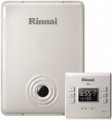Heating area
A very conditional parameter that slightly characterizes the purpose based on the size of the room. And depending on the height of the ceilings, layout, building design and equipment, actual values may differ significantly. However, this item represents the maximum recommended area of the room that the boiler can effectively heat. However, it is worth considering that different buildings have different thermal insulation properties and modern buildings are much “warmer” than 30-year-old and especially 50-year-old houses. Accordingly, this item is more of a reference nature and does not allow us to fully assess the actual heated area. There is a formula by which you can derive the maximum heating area, knowing the useful power of the boiler and the climatic conditions in which it will be used; For more information on this, see "Useful Power". In our case, the heating area is calculated using the formula “boiler power multiplied by 8”, which is approximately equivalent to use in houses that are several decades old.
Remote control unit
Remote control unit that allows you to control the boiler from another room. It can be connected both wired and wirelessly, often equipped with an electronic display to indicate operating modes, set temperature, emergency situations, etc. Many of these units are advanced devices with the ability to programme the operation of the boiler, for example, for a week; some models can be equipped with temperature sensors that automatically adjust the intensity of the boiler depending on the temperature in the room.
Heat output
It is the maximum useful power of the boiler.
The ability of the device to heat a room of a particular area directly depends on this parameter; by power, you can approximately determine the heating area, if this parameter is not indicated in the specs. The most general rule says that for a dwelling with a ceiling height of 2.5 – 3 m, at least 100 W of heat power is needed to heat 1 m2 of area. There are also more detailed calculation methods that take into account specific factors: the climatic zone, heat gain from the outside, design features of the heating system, etc.; they are described in detail in special sources. Also note that in dual-circuit boilers (see "Type"), part of the heat generated is used to heat water for the hot water supply; this must be taken into account when evaluating the output power.
It is believed that boilers with a power of more than 30 kW must be installed in separate rooms (boiler rooms).
Power consumption
The maximum electrical power consumed by the boiler during operation. For non-electric models (see Energy source), this power is usually low, as it is required mainly for control circuits and it can be ignored. Regarding electric boilers, it is worth noting that the power consumption in them is most often somewhat higher than the useful one since part of the energy is inevitably dissipated and not used for heating. Accordingly, the ratio of useful and consumed power can be used to evaluate the efficiency of such a boiler.
Coolant min. T
The minimum operating temperature of the heat medium in the boiler system when operating in heating mode.
Coolant max. T
The maximum operating temperature of the heat medium in the boiler system when operating in heating mode.
DHW circuit max. pressure
The maximum pressure in the hot water circuit (DHW) at which it can operate for a long time without failures and damage. See "Heating circuit maximum pressure".
DHW max. T
The maximum temperature of domestic hot water supplied by a dual-circuit boiler. For comparison, we note that water begins to be perceived as warm, starting from 40 °C, and in centralized hot water supply systems, the temperature of hot water is usually about 60 °C (and should not exceed 75 °C). Accordingly, even in the most modest models, this figure is about 45 °C, in the vast majority of modern boilers, it is not lower than 50 °C, and in some models, it can even exceed 90 °C.
Also when heated to a given temperature, the temperature difference ("ΔT") may be different — depending on the initial temperature of the cold water. And the performance of the boiler in the DHW mode directly depends on ΔT; see below for performance details.
"Summer" mode
It is an operating mode designed for the warm season. In this mode, it works only to provide domestic hot water, and the heating is turned off. If the boiler is equipped with an outside temperature sensor, this sensor is also switched off in
summer mode so that the heating does not turn on at night when the outside temperature drops.

